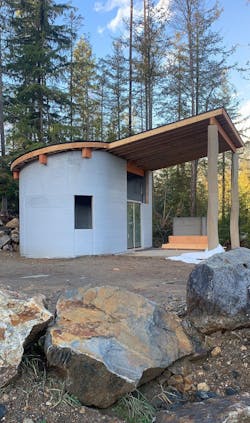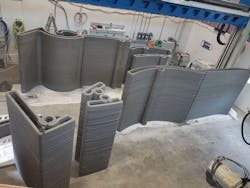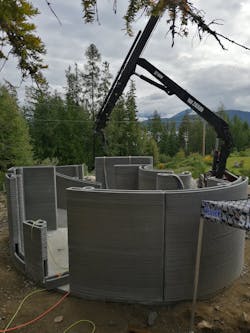The Fibonacci House: A test case of 3D construction printing
The construction industry is finally starting to undergo its digital transformation long after many other industries have adopted computerized manufacturing. As the construction industry strives to provide higher quality products, increase productivity, compensate for a lack of skilled labor, and improve working conditions, it is looking to 3D construction printing (3DCP) to help overcome these obstacles. 3D construction printing (also known as additive manufacturing) is a digitally native construction practice in which layers of printable 3D mortar are used to construct free-form objects.
This article is based on the construction of a livable and permitted home in Canada that was 3D-printed using Laticrete 3D Printing Mortar M68. The project is the subject of a technical paper, “The assessment of the buildability and interlayer adhesion strength of 3D mortar,” which will be presented at the Symposium on Standards Development for Cement and Concrete for Use in Additive Construction administered by the American Society for Testing and Materials.
Various components of the 3D-printed structure at the job site in British Columbia. Photo: Twente Additive Manufacturing
COMPLEX GEOMETRIES INSPIRED BY MEDIEVAL MATHEMATICIAN
The Fibonacci House, which we have named after Leonardo Fibonacci, the medieval Italian mathematician, illustrates the potential of 3DCP and demonstrates how a complex design and challenging logistics can be solved through pragmatic planning and 3DCP technology. The Twente AM team executed a build of a micro-house from design to completion in just a couple of months. Segments were printed in a controlled job site factory and assembled on site.
To better anticipate worst-case scenarios in regard to buildability, Twente AM was able to develop a test procedure to provide a conservative timeline in which to manage the project and ensure continuous printing
One of the key points we wanted to showcase is that the 3DCP does not require concrete housing structures to be built in rectangular shapes, while staying low-cost. The team printed a very difficult geometry based on the Fibonacci Curve to demonstrate how the versatility of the technology. The wall shapes are not only in the form of arcs, but the arc radius itself was constantly increased through the architectural layout of the structure. Building uniquely shaped walls that are transportable once printed required a structural design in tandem with a mortar formulation that could allow architectural and building flexibility.
The other major challenge was ensuring code officials that the structure would be safe. Working closely with the Laticrete team, Twente AM compiled the mechanical properties of the 3D mortar—strengths, freeze-thaw performance, thermal conductivity, and coefficient of thermal expansion. The Regional District of Central Kootenay, B.C., where the Fibonacci house was built, has the capacity to acknowledge engineering calculations as a substitute for known construction conditions. The building officials accepted the use of the Laticrete 3D Printing Mortar as a nonconventional leave-in-place formwork material. This allowed Twente AM to erect the house as quickly as we did.
Structural elements with complex geometries are put in place for the 3D-printed building. Photo: Twente Additive Manufacturing
NEW POSSIBILITIES FOR AN ANCIENT BUILDING MATERIAL
3DCP is challenging the status quo of concrete as a building material, to test new aspects of flow characteristics and curing performance. The implementation of new use cases for such an old building material is forcing the industry to realize that the time-honored technique of using solid fully filled forms is going to be replaced by optimized geometry with strategically placed voids for weight reduction and unnecessary material waste—a process made possible by 3D concrete printing.
The site where the Fibonacci house sits is slated to receive several more iterations of 3D-printed buildings with the objective to make more complicated free-form structures and better cost and energy usage efficiencies. Together, Laticrete and Twente AM have been consulting around the world to make 3DCP a sustainable and scalable solution in building construction.
The Fibonacci House nears completion. The building was 3D-printed using Laticrete 3D Printing Mortar M68. Photo: Kelley Deon
ABOUT THE AUTHORS
Matthew Carli is Director of Innovation and Strategic Planning at LATICRETE International. Kho Verian, PhD, a scientist at LATICRETE International, leads the development of LATICRETE 3D printing materials. Ian Comishin is Founder and President of Twente Additive Manufacturing B.V., Enschede, Netherlands.



